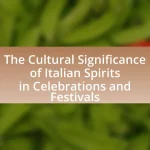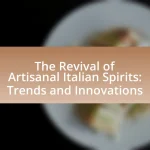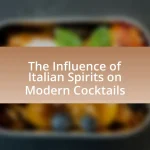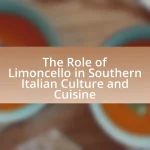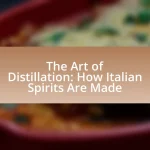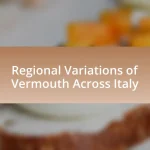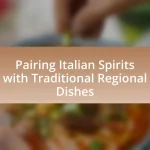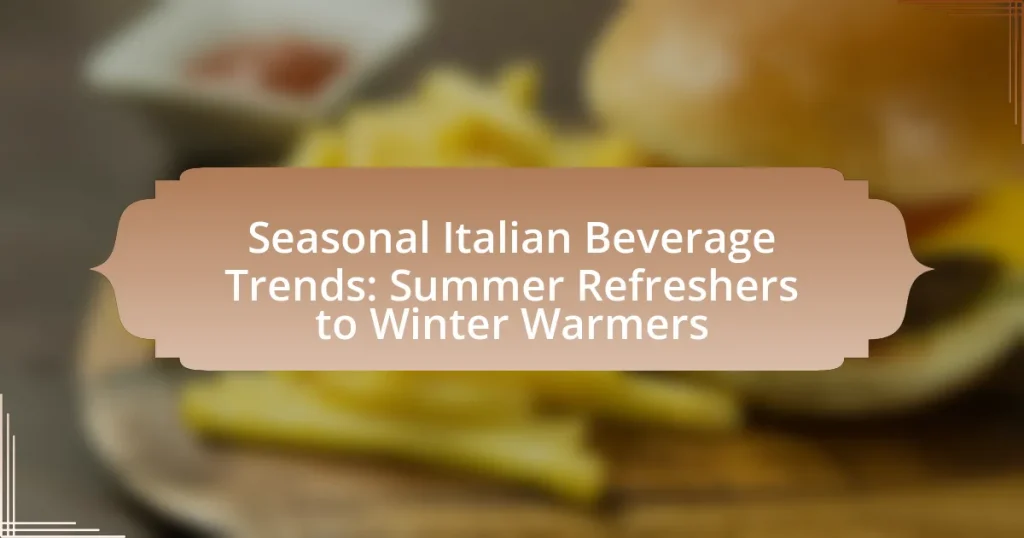Seasonal Italian beverage trends highlight the diverse drinks enjoyed throughout the year, with summer featuring refreshing options like Aperol Spritz and limoncello, while winter emphasizes warm beverages such as vin brulé and hot chocolate. These trends are shaped by regional ingredients and cultural traditions, reflecting Italy’s rich culinary heritage. The article explores how seasonal changes influence beverage preferences, the characteristics of summer and winter drinks, and the importance of these beverages in Italian culture and social gatherings. Additionally, it discusses emerging trends, sustainability in production, and offers recipes for creating these seasonal beverages at home.
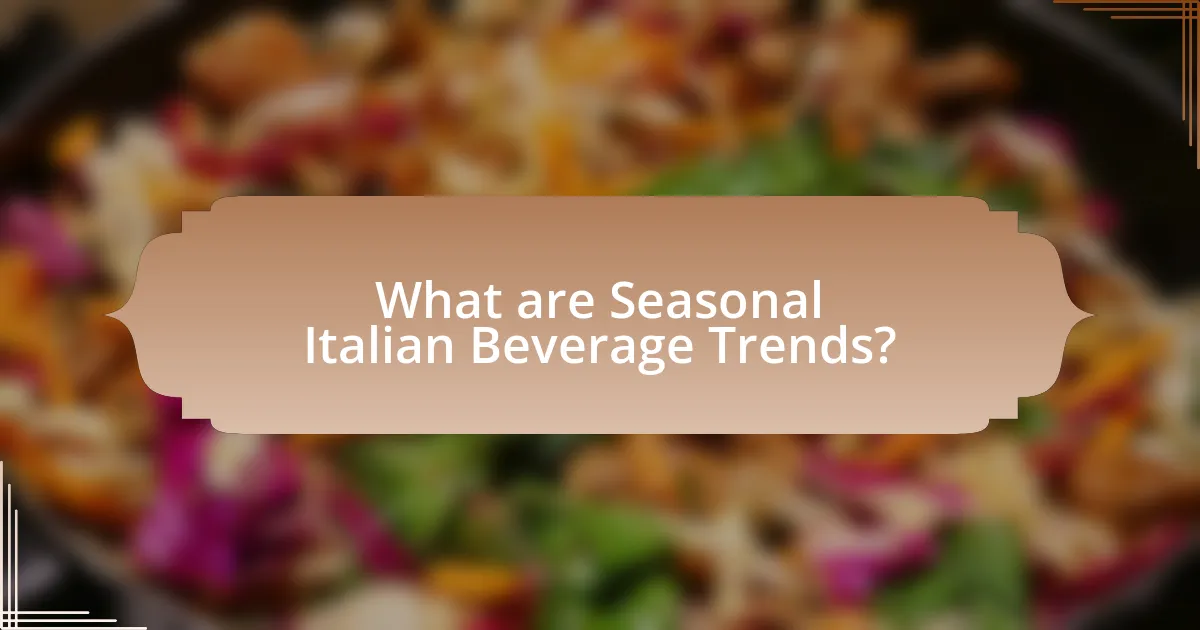
What are Seasonal Italian Beverage Trends?
Seasonal Italian beverage trends include a variety of drinks that reflect the changing seasons, with summer featuring refreshing options like Aperol Spritz and limoncello, while winter emphasizes warm beverages such as vin brulé (mulled wine) and hot chocolate. These trends are influenced by regional ingredients and traditional practices, showcasing Italy’s rich culinary heritage. For example, the popularity of Aperol Spritz in summer aligns with the Italian tradition of enjoying light, citrusy drinks during warm weather, while vin brulé is a staple at winter markets, highlighting the use of spices and red wine in colder months.
How do seasonal changes influence beverage preferences in Italy?
Seasonal changes significantly influence beverage preferences in Italy, with warmer months favoring refreshing drinks and colder months prompting a shift to warming beverages. During summer, Italians commonly choose chilled drinks such as spritzes, iced coffee, and fruit-based cocktails, reflecting a desire for hydration and refreshment in hot weather. In contrast, winter months see a rise in the consumption of hot beverages like mulled wine, espresso, and rich hot chocolate, as these options provide warmth and comfort during colder temperatures. This pattern is supported by cultural traditions and regional variations, where specific beverages are associated with seasonal festivities and local ingredients, reinforcing the connection between climate and beverage choices in Italy.
What are the key characteristics of summer beverages in Italy?
Summer beverages in Italy are characterized by their refreshing nature, vibrant flavors, and use of seasonal ingredients. These drinks often include ingredients like fresh fruits, herbs, and sparkling water, which enhance their cooling properties. Popular examples include the Aperol Spritz, made with Aperol, Prosecco, and soda water, and various fruit-based granitas, which are icy treats made from pureed fruits and sugar. The emphasis on local and seasonal produce, such as lemons from the Amalfi Coast or peaches from Emilia-Romagna, further defines these beverages, making them not only refreshing but also a celebration of Italy’s rich agricultural heritage.
What are the defining features of winter beverages in Italy?
Winter beverages in Italy are characterized by their warmth, rich flavors, and traditional ingredients. Popular drinks include hot chocolate, often made with high-quality dark chocolate and milk, creating a thick and indulgent texture. Additionally, mulled wine, known as “vin brulé,” is spiced with cinnamon, cloves, and citrus, enhancing its aromatic profile. Another defining feature is the use of local spirits, such as grappa or amaro, which are often incorporated into cocktails or served neat to provide warmth during the cold months. These beverages reflect Italy’s culinary heritage and regional variations, showcasing seasonal ingredients and traditional preparation methods.
Why are seasonal beverages important in Italian culture?
Seasonal beverages are important in Italian culture because they reflect regional traditions and seasonal ingredients, enhancing social interactions and culinary experiences. For instance, drinks like Aperol Spritz in summer and Vin Brulé in winter are not only popular but also symbolize the Italian lifestyle of enjoying life through food and drink. These beverages often incorporate local flavors and ingredients, showcasing Italy’s rich agricultural diversity. Additionally, seasonal beverages play a role in cultural celebrations and rituals, reinforcing community bonds and shared heritage.
How do seasonal beverages reflect regional ingredients and traditions?
Seasonal beverages reflect regional ingredients and traditions by utilizing locally sourced components that embody the cultural heritage of a specific area. For example, in Italy, summer beverages often feature fresh fruits like lemons from the Amalfi Coast or peaches from Emilia-Romagna, highlighting the region’s agricultural bounty and culinary practices. In contrast, winter beverages may incorporate spices and warming ingredients such as vin brulé, which uses local red wines and spices, reflecting the colder climate and traditional festive customs. This connection between ingredients and local traditions not only enhances the flavor profile of the beverages but also reinforces the identity and history of the region, as seen in the popularity of beverages like Negroni in Tuscany or Bombardino in the Alps during winter months.
What role do seasonal beverages play in Italian social gatherings?
Seasonal beverages are central to Italian social gatherings, enhancing the communal experience and reflecting cultural traditions. These drinks, such as Aperol Spritz in summer and Vin Brulé in winter, serve not only as refreshments but also as catalysts for social interaction, fostering connections among friends and family. The tradition of sharing these beverages during festive occasions, like Christmas or summer festivals, underscores their role in creating a sense of belonging and celebration within Italian culture.
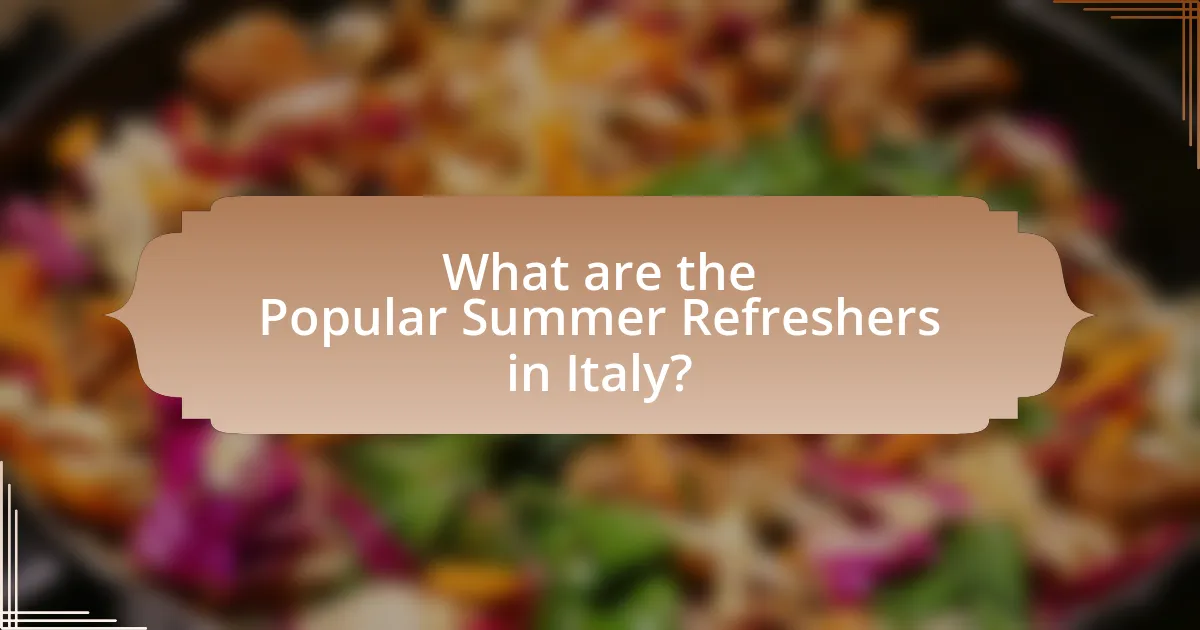
What are the Popular Summer Refreshers in Italy?
Popular summer refreshers in Italy include Aperol Spritz, Limoncello, and Granita. Aperol Spritz, a cocktail made with Aperol, Prosecco, and soda water, is widely enjoyed for its refreshing taste and vibrant color. Limoncello, a lemon liqueur, is often served chilled as a digestif, providing a zesty and cooling effect. Granita, a semi-frozen dessert made from sugar, water, and various flavorings, is particularly popular in Sicily, offering a refreshing treat during hot summer days. These beverages are staples in Italian summer culture, celebrated for their ability to cool down and refresh in the warm climate.
What types of beverages are considered summer refreshers?
Summer refreshers typically include beverages that are light, hydrating, and often served cold. Common examples are iced teas, lemonade, fruit-infused waters, and sparkling beverages like Italian sodas. These drinks are popular during the summer months due to their refreshing qualities and ability to quench thirst in hot weather. For instance, lemonade has been a traditional summer drink since the 19th century, known for its cooling effect and citrus flavor, making it a staple in summer refreshment.
How do Italian spritzes embody summer refreshment?
Italian spritzes embody summer refreshment through their vibrant flavors, effervescence, and refreshing ingredients. The combination of prosecco, bitter liqueur, and soda water creates a light, bubbly drink that is both invigorating and easy to sip on warm days. Additionally, the use of fresh citrus garnishes, such as orange slices, enhances the drink’s appeal by adding a zesty aroma and flavor, which is synonymous with summer enjoyment. The spritz’s origins in Italy, particularly in regions like Veneto, further connect it to leisurely summer gatherings, making it a quintessential choice for outdoor socializing during the season.
What are the most popular fruit-based summer drinks in Italy?
The most popular fruit-based summer drinks in Italy include granita, a semi-frozen dessert made from sugar, water, and various flavorings, often featuring fruits like lemon, almond, or watermelon. Another favorite is the Italian spritz, typically made with Aperol or Campari, prosecco, and a splash of soda, garnished with orange slices. Additionally, fruit-infused water and smoothies made from seasonal fruits such as peaches, strawberries, and cherries are widely enjoyed. These drinks reflect Italy’s emphasis on fresh, local ingredients and are commonly served in cafes and restaurants during the summer months.
How are summer beverages typically served in Italy?
Summer beverages in Italy are typically served chilled and often accompanied by ice. Commonly enjoyed drinks include Aperol Spritz, which is served in a large wine glass with ice and garnished with an orange slice, and granita, a semi-frozen dessert that is served in a cup or bowl. Additionally, Italian sodas and fresh fruit juices are frequently served over ice, enhancing their refreshing qualities during the hot summer months. These serving styles reflect Italy’s emphasis on enjoying beverages that are both visually appealing and cooling, aligning with the country’s culinary traditions.
What garnishes and accompaniments enhance summer drinks?
Citrus fruits, herbs, and flavored syrups are key garnishes and accompaniments that enhance summer drinks. Citrus fruits like lemon, lime, and orange add brightness and acidity, which balance sweetness and elevate flavors. Fresh herbs such as mint and basil provide aromatic freshness, complementing fruity and herbal notes in beverages. Additionally, flavored syrups, including elderflower or hibiscus, can introduce unique tastes and sweetness, making drinks more refreshing. These elements are commonly used in summer cocktails and non-alcoholic beverages to create a vibrant and enjoyable drinking experience.
How does presentation affect the enjoyment of summer beverages?
Presentation significantly enhances the enjoyment of summer beverages by influencing perceptions of taste and overall experience. Visually appealing drinks, characterized by vibrant colors, garnishes, and stylish glassware, create anticipation and excitement, which can elevate the sensory experience. Research indicates that aesthetics can impact taste perception; for instance, a study published in the journal “Food Quality and Preference” found that participants rated beverages as more flavorful when they were presented attractively. This suggests that the visual elements of presentation not only enhance enjoyment but also affect the perceived quality of the beverage itself.
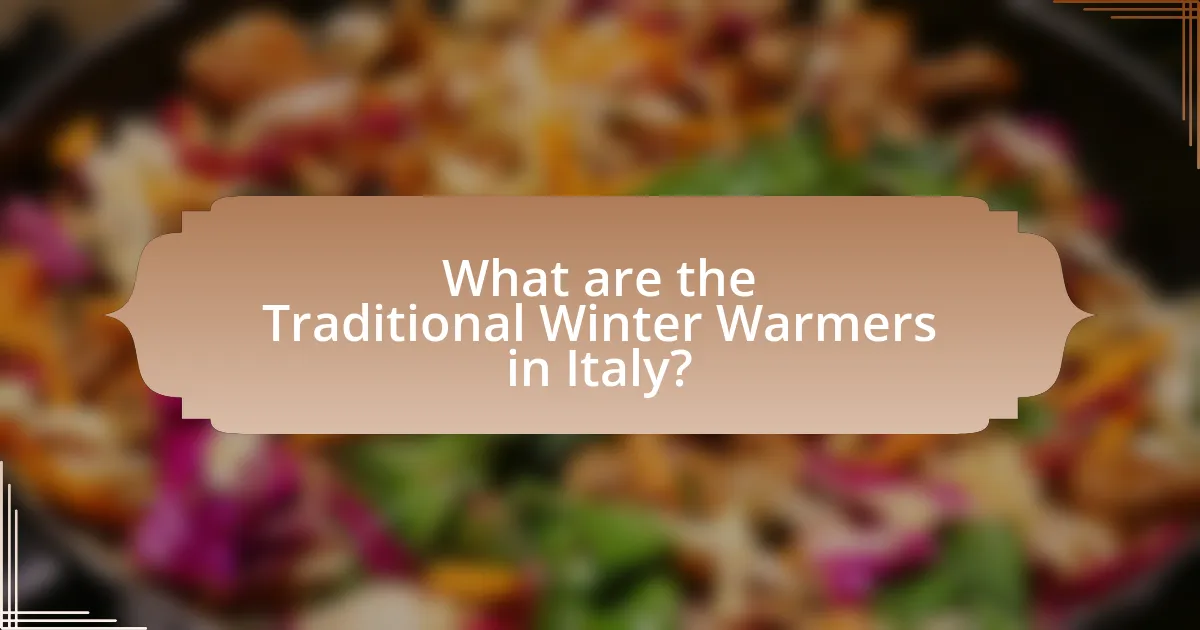
What are the Traditional Winter Warmers in Italy?
Traditional winter warmers in Italy include beverages such as Vin Brulé, a spiced mulled wine, and Cioccolata Calda, a rich hot chocolate. Vin Brulé is made by heating red wine with spices like cinnamon and cloves, often enjoyed during winter festivals and Christmas markets. Cioccolata Calda is characterized by its thick, creamy texture, often served with whipped cream, and is a popular choice in cafes during the colder months. These drinks reflect Italy’s culinary traditions and are integral to the winter experience in the country.
What beverages are commonly enjoyed during the winter months?
Commonly enjoyed beverages during the winter months include hot chocolate, mulled wine, and various herbal teas. Hot chocolate, made from cocoa powder and milk, is a traditional favorite that provides warmth and comfort. Mulled wine, typically red wine infused with spices like cinnamon and cloves, is popular in many cultures for its warming properties. Herbal teas, such as chamomile and peppermint, are also favored for their soothing effects during colder weather. These beverages not only offer warmth but also enhance the seasonal experience, making them staples in winter gatherings and celebrations.
How do hot beverages like mulled wine and cioccolata calda fit into winter traditions?
Hot beverages like mulled wine and cioccolata calda are integral to winter traditions, serving as comforting drinks that enhance social gatherings and festive celebrations. Mulled wine, often spiced with cinnamon and cloves, is traditionally consumed during Christmas markets and holiday festivities across Europe, symbolizing warmth and community. Cioccolata calda, a rich Italian hot chocolate, is commonly enjoyed during winter months, particularly in Italy, where it is associated with cozy family moments and seasonal festivities. Both beverages not only provide physical warmth but also foster a sense of togetherness, reflecting cultural practices that emphasize hospitality and celebration during the colder months.
What are the unique ingredients used in winter warmers?
Unique ingredients used in winter warmers include spices such as cinnamon, nutmeg, and cloves, as well as rich components like dark chocolate and fortified wines. These ingredients are commonly utilized in traditional Italian beverages like Vin Brulé, which is spiced red wine heated with sugar and citrus, and Bombardino, a creamy drink made with eggnog and brandy. The use of these specific ingredients not only enhances the warmth and comfort associated with winter beverages but also reflects the seasonal flavors that are popular in Italian culture during colder months.
How do winter beverages contribute to holiday celebrations in Italy?
Winter beverages play a significant role in holiday celebrations in Italy by enhancing social gatherings and traditional festivities. Popular drinks such as hot chocolate, mulled wine (vin brulé), and various herbal infusions create a warm and inviting atmosphere during the colder months. These beverages are often enjoyed during family gatherings, Christmas markets, and New Year’s celebrations, fostering a sense of community and shared experience. Additionally, the preparation and consumption of these drinks are tied to regional customs and recipes, reflecting Italy’s rich culinary heritage and seasonal traditions. For instance, vin brulé is commonly served at Christmas markets across Italy, symbolizing warmth and togetherness during the festive season.
What are the rituals associated with serving winter warmers during festivities?
Rituals associated with serving winter warmers during festivities include the preparation and sharing of traditional beverages like mulled wine and hot chocolate. These drinks are often served in communal settings, emphasizing togetherness and celebration. For instance, in Italy, the practice of serving vin brulé, a spiced red wine, is common during Christmas markets, where it is enjoyed alongside festive foods. The act of warming the beverages symbolizes comfort and hospitality, reinforcing social bonds among family and friends during the colder months. Additionally, specific garnishes, such as cinnamon sticks or citrus peels, are often included to enhance flavor and create a festive atmosphere, reflecting cultural traditions and seasonal ingredients.
How do family recipes influence winter beverage choices?
Family recipes significantly influence winter beverage choices by preserving traditional flavors and techniques that evoke nostalgia and cultural identity. These recipes often feature ingredients like spices, citrus, and rich flavors that are characteristic of winter beverages, such as mulled wine or hot chocolate. For instance, a family recipe for spiced cider may include cloves and cinnamon, which not only enhance the drink’s warmth but also connect individuals to familial traditions and memories. This connection to heritage can drive preferences for specific beverages during the winter season, as people seek comfort in familiar tastes that remind them of family gatherings and celebrations.
What are the emerging trends in seasonal Italian beverages?
Emerging trends in seasonal Italian beverages include a growing popularity of low-alcohol and non-alcoholic options, particularly during summer months, as consumers seek refreshing alternatives. Additionally, there is an increasing interest in craft and artisanal production methods, leading to unique flavors and local ingredients being highlighted in beverages like spritzes and herbal infusions. The trend towards sustainability is also evident, with many producers focusing on eco-friendly packaging and organic ingredients. These trends reflect a shift in consumer preferences towards health-conscious and environmentally responsible choices in the beverage market.
How are modern interpretations of traditional beverages changing the landscape?
Modern interpretations of traditional beverages are transforming the landscape by blending classic recipes with contemporary flavors and techniques, appealing to a broader audience. For instance, the revival of Italian spritzes incorporates innovative ingredients like flavored bitters and artisanal sodas, enhancing the traditional aperitivo experience. This shift not only attracts younger consumers but also promotes a culture of experimentation, as seen in the rise of craft cocktails that reinterpret classic Italian drinks with local and seasonal ingredients. The integration of sustainability practices, such as using organic produce and reducing waste, further reflects changing consumer preferences towards health and environmental consciousness.
What role does sustainability play in the production of seasonal beverages?
Sustainability plays a crucial role in the production of seasonal beverages by ensuring environmentally friendly practices throughout the supply chain. This includes sourcing ingredients locally to reduce carbon footprints, utilizing organic farming methods to minimize chemical use, and implementing water conservation techniques during production. For instance, many Italian beverage producers focus on using seasonal fruits and herbs, which not only enhances flavor but also supports local agriculture and reduces transportation emissions. Additionally, sustainable packaging solutions, such as recyclable materials, are increasingly adopted to lessen waste. These practices contribute to a more responsible beverage industry that aligns with consumer demand for eco-friendly products.
How can one create seasonal Italian beverages at home?
To create seasonal Italian beverages at home, one can utilize fresh, seasonal ingredients and traditional recipes. For summer, prepare a classic Italian Spritz by mixing Prosecco, Aperol, and soda water, garnished with an orange slice. In winter, craft a warming Vin Brulé by simmering red wine with spices like cinnamon, cloves, and orange zest. These beverages reflect the essence of Italian culture and seasonal flavors, making them authentic and enjoyable.
What are some easy recipes for summer refreshers?
Some easy recipes for summer refreshers include watermelon mint cooler, lemon basil spritzer, and peach iced tea. The watermelon mint cooler combines fresh watermelon juice, mint leaves, and lime juice, creating a hydrating drink rich in vitamins A and C. The lemon basil spritzer mixes lemon juice, fresh basil, and sparkling water, offering a refreshing taste with antioxidants. Peach iced tea is made by brewing black tea, adding fresh peach slices, and sweetening with honey, providing a flavorful beverage with polyphenols that promote heart health. These recipes are simple to prepare and utilize seasonal ingredients, making them ideal for summer enjoyment.
What tips can enhance the preparation of winter warmers?
To enhance the preparation of winter warmers, focus on using high-quality ingredients and incorporating spices that evoke warmth, such as cinnamon, nutmeg, and cloves. High-quality ingredients, like fresh citrus and premium spirits, elevate the flavor profile, while spices not only add warmth but also have health benefits, such as improving circulation and boosting immunity. Additionally, slow cooking methods can deepen flavors, allowing the ingredients to meld together, resulting in a richer beverage. For example, mulled wine benefits from simmering for an extended period, which enhances its aromatic qualities and overall taste.
